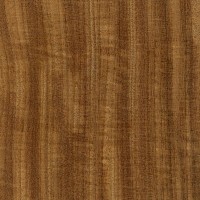

Afromosia grows in West Africa and mostly is imported from Ghana, Cameroon, and Ivory Coast. It is usually marketed as “African Teak” because it has a very similar color and grain appearance. The sapwood is narrow and is light in color, in contrast to the heartwood which is initially yellowish-brown, which loses its yellow color on exposure. The grain is typically straight to slightly interlocked, and the wood has a medium to fine texture. This species has been placed on the endangered species list and thus international trade is restricted.
Common Names
Afrormosia, Afromosia, African Teak
Origin
West Africa
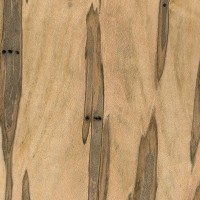
"Ambrosia" is a term that's commonly applied to lumber from eastern red and silver maples that has streaks of color caused by an infestation of the ambrosia beetle. But "ambrosia beetle" really is a generic term for many different types of beetles whose larvae bore into trees and deposit a fungal symbiont into the wood. This fungus breaks down the wood into a compound that the larvae can eat. Beetles usually infest dead or dying trees and often will enter the trunk through a broken branch or other injury.
The ambrosia figure has a tapered, oblong shape running with the grain, and usually a grayish color. The figure pattern can be mild or dense, depending on the degree of infestation. Ambrosia maple also is called "ghost" maple, because the stains look like ghosts suspended in the board and the larvae tunnels appear to be eyes.
Common Names
Ambrosia Maple, Wormy Maple
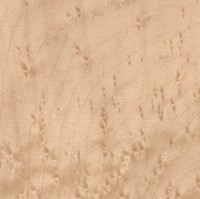
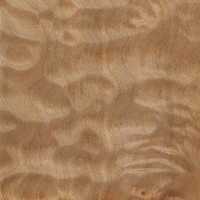
Birds's Eye Maple Quilted (Blistered) Maple
Bird's Eye maple has a distinctive pattern that looks like tiny, swirling eyes disrupting the smooth lines of grain. Birdseye maple isn't a variety or species of maple, but rather a phenomenon that occurs within several kinds of timber. The bird's eye deformation can also be found in red maple, white ash, Cuban mahogany, American beech, black walnut, and yellow birch. These trees that grow in the Great Lakes region of Canada and the United States yield the heftiest supply, along with some varieties in the Rocky Mountains.
Quilted maple is so named for its resemblance to patchwork patterns seen on fabric quilts. Much like birdseye maple, the figure on quilted maple becomes most pronounced when the board has been flatsawn, which is the opposite of curly maple, which becomes most prominent when quartersawn. Alternate names and sub-categories for this type of figuring include blistered, curly-quilt, sausage-quilt, tubular-quilt, and angel-step.
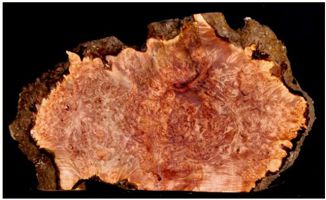 Maple Burl
Maple Burl
Burl is a grain characteristic that happens in many types of wood. Burl wood results from harvesting a tree or a portion of a tree that has a burl. A burl is a growth on a tree formed from unsprouted bud tissue. The burl forms large, knobby looking growths on the base and trunk of the tree. Stress caused by injury, fungus, virus, or insects creates intense grain patterns. In addition, rapid growth in burls causes further stress and pressure on the wood.

Bubinga is a hard, heavy wood with characteristics similar to the rosewoods. Color and density varies by species, but the heartwood is typically medium reddish brown or purplish brown with darker veining, often exhibiting dramatically chatoyant "bees-wing" mottle. Relatively hard and dense. Takes a fine finish.
Common Names
Bubinga, Kevazingo, Kewazingo, African Rosewood
Origin
Tropical West Africa, Cameroon, Gabon
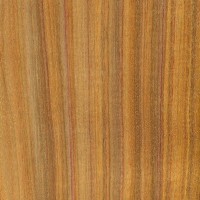
Heartwood color can vary a fair amount, from a pale yellow-orange to a darker reddish brown, usually with darker streaks throughout. Pale yellow sapwood is sharply demarcated from heartwood. Some pieces of Canarywood can be almost rainbow colored—with dark red streaks, along with the natural orange, yellow, and brown coloration.
Color tends to darken and homogenize with age
Grain is typically straight, but can be irregular or wild on some pieces. Uniform fine to medium texture with good natural luster.
Common Names
Canarywood, Canary, Yellow Tarara
Origin
South America (from Panama down to southern Brazil)

Hard, heavy wood with an even texture and a bright red to reddish yellow color. It is sometimes called Satine because it takes on a lustrous finish.
Common Names
Bloodwood, muirapiranga, cardinalwood, satine
Origin
Brazil, Peru, Venezuela, Panama

Cherry is a hard durable wood that has a reddish-brown tone with a tight, straight grain that becomes darker and richer as it ages.
It has a slight but elegant grain.
Common Names
Cherry
Origin
Canada and USA
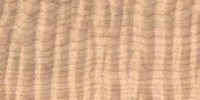 Curly
Maple
Curly
Maple
Curly Cherry 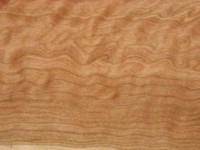
Curly is an effect within the grain caused by growth conditions. T he growth of the wood fibers is distorted in an undulating chatoyant pattern, producing spectacular wavy lines. The illusion of undulations results from regular and repeated, parallel, wavy lines that produce an interference pattern on the exposed plane. The curly effect is caused by buffeting winds that make the xylem and phloem stretch as the tree is growing. When the conditions that caused the buffeting stop-usually because surrounding trees have caught up in height-the stretched tissues collapse on themselves making the curly pattern.
Fiddleback Maple is also known as 'Flame Maple', 'Tiger Maple', 'Curly Maple', or 'Tigerstripe Maple'. Fiddleback Maple exhibits a dramatic change in the individual stripes or lines. As the incident angle of the light is slightly altered, the dark stripe becomes a light stripe, and the light stripe becomes dark. This visual phenomenon is known as 'chatoyancy' in the gemstone world, and its most dramatic form is seen in catseye chrysoberyl.
True Fiddleback figuring is not to be confused with "compression grain" or "stress grain" found where roots merge into the bole and also on the underside of large limbs. Some differentiate between Curly and Fiddleback figuring. For instance, curly cherry and curly birch can exhibit much swirls, waves and curls, though they are far more irregular and large, often appearing as flattened arches stacked one on top of another over the length of the board. Fiddleback Maple (Flame Maple, Tiger Maple) grain is generally considered to be more pronounced with tighter striping, sometimes measured as tight as several stripes per inch. Unlike many forms of curly grain, Fiddleback describes a series of tight, parallel (or nearly parallel) stripes running perpendicular to the length of the board.
The terms Fiddleback Maple and Curly Maple are used synonymously. Fiddleback Maple boasts a three-dimensional series of alternately bright and dark stripes that shade into one another as the wood is slightly moved, thus producing an illusion of actual waves. Changes in brightness result from differential light reflection. Relatively high absorption by exposed fiber ends produces dark bands; reflection and diffraction from fiber walls cause bright bands. Because the fiber walls are curved sharply and act as concave or convex reflecting surfaces, any change in angle of view or incident light makes the apparent waves seem to shift. Again, the same light stripe becomes a dark stripe and vice-versa.
Fiddleback Maple is well-known, greatly esteemed, and eagerly sought by wood aficionados.
It is one of the world's most transfixingly beautiful exotic hardwoods.
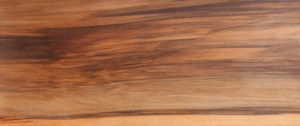
The wood surface exhibits a satiny luster. The nickname Satin walnut for Sweetgum is believed to have come from the beautiful satin-like luster.
The heartwood (or redgum) is much more colorful than the sapwood. It ranges in color from pinkish brown to a deep full-bodied red. Streaks of black may also be present. The heartwood frequently has darker streaks of pigment figure called figured redgum. The figure is especially prominent in flat sawn timber. A limited amount of red gum has an unusual grain pattern, usually referred to as 'flame grain'.
The sapwood (also called sap gum) is creamy white, often with a pinkish tinge. It is often discolored with blue sap stain. The sapwood has a plain pattern which has been described as watery.
Common Names
American Sweet Gum, American red gum, Red gum, Sap gum, Satin walnut, Alligator tree
Origin
native range extends from Missouri to Connecticut and from the Ohio River Valley south to the Gulf of Mexico, but it grows best on river flood plains deep in Dixie from Louisiana through Alabama. It also grows in scattered locations in northwestern and central Mexico, Guatemala, Belize, Salvador, Hondurus, and Nicaragua
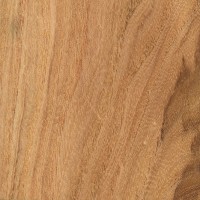
Heartwood is a medium to light reddish brown. Wide sapwood is a light yellow, clearly distinguished from the heartwood. Very similar in appearance to Kentucky Coffeetree.
Grain is usually straight or slightly irregular, with a medium uneven texture. Moderate natural luster.
Not widely or commonly available, limited quantities of Honey Locust are sometimes available within its natural range.
Common Names
Honey Locust
Origin
South-central and eastern United States

The heartwood is yellow-olive to a chocolate brown, with variegated streaks and stripes. The wood has been compared to American walnut in appearance, hence the nickname, Brazilian walnut. Color variation is reported to be rather high.
Grain is straight but occasionally curly or wavy, producing a ribbon figure.
Imbuya can have a variety of looks, from burly to cluster burls, quilted, and bubbly.
Texture is typically fine, and is similar to that of walnut, birch or maple.
Common Names
Imbuya, Amarela, Brazilian walnut, Canella imbuia, Determa, Embuia, Embuya, Imbuia
Origin
Brazil

Heartwood ranges from olive-brown to reddish-black. Very resistant to the elements, making it a popular choice for outdoor decking and construction, including bridges. Difficult to work, especially with hand tools. Has a blunting effect on tools.
Common Names
Ipe, lapacho, hakia, bethabara
Origin
Plentiful throughout tropical America, especially Brazil, and some of the Lesser Antilles
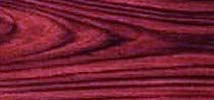
Brazilian Kingwood is a beautiful member of the rosewood family. It is an exotic wood that is light to dark violet brown with lighter and darker stripes of purple. Bright luster, fine texture and is very stable in service. Very hard and heavy. Takes a high natural polish and develops patina as it ages.
Fairly rare and very expensive. Seldom available as lumber. Kingwood is most often seen as smaller turning stock, with its cost being on par with other scarce exotics. Kingwood is seldom available in large pieces due to the small size of the tree itself, and is instead used as accent pieces.
Common Names
Kingwood, Violete, Violet Wood, Bois Violet
Origin
Brazil


The distinguishing feature of lacewood is the prominent ray flecks, especially on quartersawn material. Flecks may be small and tight or large and dramatic. Sapwood is cream colored and moderately defined. Yellowish brown heartwood. Grain is straight to wavy. Medium to coarse texture. Lustrous.
Common Names
Lacewood, silky-oak, southern silky-oak, grevillea, kawilia
Origin
Eastern Australia
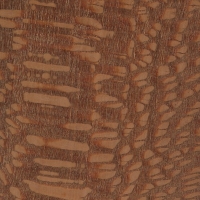
Has a very conspicuous flecking that gives this wood its namesake. The wood itself is a medium to dark reddish brown with grey or light brown rays, which resemble the spots of a leopard. Like other woods that exhibit the strongest figure in quartersawn pieces, (such as Sycamore), Leopardwood has the most pronounced figure and displays the largest flecks when perfectly quartersawn; this is due to the wood’s wide medullary rays, whose layout can be seen the clearest when looking at the endgrain.
Leopardwood is frequently confused with Lacewood, and is sometimes referred to as such. Leopardwood can usually be separated from most species of Lacewood based upon its darker color and higher density.
Common Names
Leopardwood
Origin
Central and South America
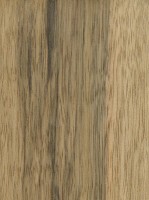
Heartwood is a light yellowish to golden brown, sometimes with grey to nearly black streaks and veins. Wood with such darker figuring is referred to as Black Limba, while plain unfigured wood is called White Limba. Sapwood is a pale greyish to yellowish brown, not clearly demarcated from the heartwood. Color tends to darken with age.
Typically, Black Limba wood is characterized by attractive black striping, orange ambrosia streaks and residual bug holes from the creatures responsible for imprinting those streaks.
Common Names
Limba, Black Limba, White Limba, Korina, Afara
Origin
Tropical western Africa
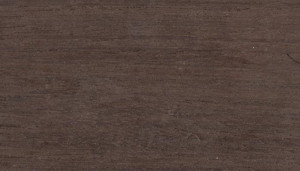
Heartwood tends to be darker than temperate walnut species, with a deep chocolate brown color, sometimes with a purplish hue. May also contain streaks of lighter-colored wood mixed throughout the heartwood, which can sometimes be extensive and result in a high degree of waste. Grain figuring such as curl seems to be much less common than other walnut species.
Common Names
Peruvian Walnut, Tropical Walnut, Nogal
Origin
Southern Mexico, Central & South America
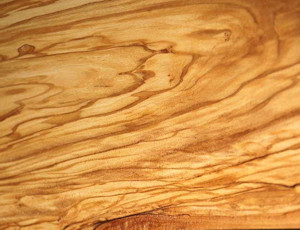
Olive wood is hard, heavy and strong with a high overall density. It has a straight grain with a fine
texture. Due to its rich color and appearance, olive wood is a particularly sought-after material for use in decorative items. The wood contains brown streaks that contrast attractively with the lighter yellow streaks of the sapwood. Olive wood takes very well to polishing, and a fine luster can be achieved.
Olive wood is rarely sold or available as lumber. When it is sold, olive wood lumber is normally very expensive and cut into small pieces. The wood is often used to make small items, such as ornamental knife handles and jewelry boxes. Larger finished objects are scarce, highly desirable and expensive.
Common Names
Olive
Origin
Europe and eastern Africa
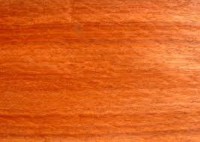
There are three species of trees that produce wood that is called padauk--Burma padauk, Andaman padauk (named for the Andaman Islands where it grows), and African padauk. All are red when cut, but darken with exposure to light. Usually fairly dense and heavy, coarse textured, with prominent open pores.
Common Names
African padauk, Burma padauk, Andaman padauk
Origin
Nigeria, Cameroons and the Congos, Burma, Andaman Islands

Purpleheart is brown when freshly cut but oxidizes to a bright violet purple and eventually to a dark purplish brown. Hard, heavy and finely textured, purpleheart's grain is usually straight, often with a fine, curly figure. There is considerable variation in color, texture and density among the several species that account for commercial supplies of purpleheart. It is moderately hard to work but takes a glossy, lustrous finish.
Common Names
Purpleheart, amaranth, violetwood
Origin
Central and South America
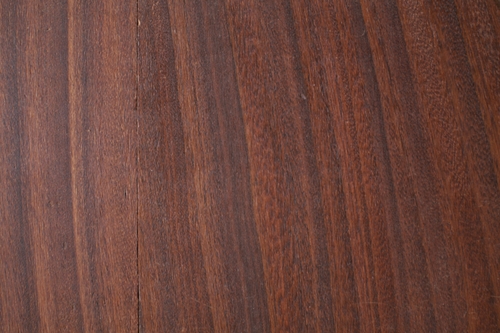
Caribbean Rosewood is one of the world’s most beautiful woods with a rosewood look that offers unique coloration and graining.
It provides an extreme range of color variability. This wood ranges from cream colored, flame type, swirls on through to gold/orange highlights on top of a medium brown background with black striping.
It exhibits a medium degree of color change, with the muting of the color variation and some darkening over time.
Common Names
Carribean Rosewood, Nanciton, Rosita
Origin
Brazil, Colombia, Honduras, Nicaragua, Panama, Peru, Suriname, Venezuela
The species is reported to grow from southern Mexico through Central and South America to southern Brazil.

This exotic wood earns high marks for beauty with a heartwood that is medium-to-dark brown and sometimes purple with bold dark brown to dark purple streaks. The dark streaks show the termination of growth marks. Some boards have an attractive ribbon-stripe grain. Sapwood is yellowish. The wood has a uniform texture. Rosewood is so named for the fragrance of roses the cut wood produces when first cut. It has no taste or odor when the material is seasoned.
Purple-brown heartwood with attractive dark streaks and yellowish white sapwood, often with a purple tinge. Commonly interlocked grain with a uniform, moderately coarse texture. Heavy, hard, and dense.
Common Names
East Indian rosewood, Bombay rosewood, bombay blackwood, shisham, sitsal, malabar, sissoo, biti, ervadi, and kalaruk
Origin
India, Sri Lanka and Indonesia
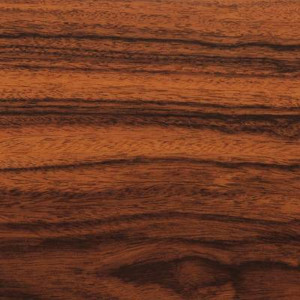
The wood has been used in various capacities as a substitute for the endangered Brazilian Rosewood. Although the wood is not technically in the Dalbergia genus, it’s in a closely-related genus (Machaerium), and contains the same sensitizing compounds found in rosewoods—about as close to a true rosewood as a wood can get without actually being a Dalbergia species.
A reddish purple to light brown to black brown material with lively grain and occasional streaks of cream sapwood. The lighter red and more striking the color, the higher is the value of the wood. Very decorative light brown to black-brown veins; the fiber structure is partly parallel, partly very intricate.
Common Names
This is a wood of many names, and is sometimes called Pau Fero or Morado: and because the wood is so similar in appearance and working properties to rosewood, it is also sometimes referred to as Bolivian or Santos Rosewood.
Origin
South America (Brazil, Bolivia)
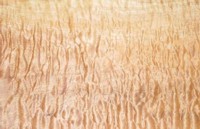
Curly and Bird's Eye are
effects within the grain caused by growth conditions. Bird's Eye is created by a stress on the tree like a prolonged drought that causes the tree to throw out many little branches along its trunk.
Curly is caused by buffeting winds that make the xylem and phloem stretch as the tree is growing. When the conditions that caused the buffeting stop-usually because surrounding trees have caught up in height-the stretched tissues collapse on themselves making
the curly pattern. Quilted happens when both conditions exist in one tree. While these are not really rare occurrences, they are unusual and make the resulting wood more desirable for one-of-a-kind furniture
and box making.
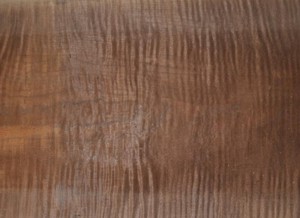
This is a picture of roasted curly maple.
Roasted, or torrefied wood, is a wood that has been treated at a very high temperature without chemicals. The hardwood is then rehumidified in order to achieve a uniformly colored material. The resultant color (coffee) is similar to one of Black Walnut. The uniform color is consistently throughout the boards.
Common Names
Roasted Hardwood or Bois Torriefie.
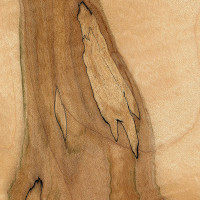
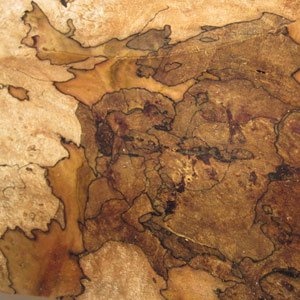
These are pictures of spalted maple.
Much like Ambrosia Maple and other forms of figured maple, Spalted Maple is technically not a specific species of Maple, but rather a general description of any type of Maple that has been allowed to begin initial stages of decay, and then subsequently dried (preventing further decay).
The partial decay, called spalting, gives the wood dark contrasting lines and streaks where fungus has begun to attack the wood. If the wood has been rescued from the spalting at the right time, the lumber should still be sound and usable, with little to no soft spots or rotten wood.

Similar to maple, the wood of Sycamore trees is predominantly comprised of the sapwood, with some darker heartwood streaks also found in most boards. (Though it is not uncommon to also see entire boards of heartwood too.) The sapwood is white to light tan, while the heartwood is a darker reddish brown. Sycamore also has very distinct ray flecks present on quartersawn surfaces—giving it a freckled appearance—and it is sometimes even called “Lacewood,” though it bears little botanical relation to the tropical species of Lacewood.
Common Names
American sycamore, buttonwood, buttonball, plane, ghost tree, American planetree, water beech, whitewood and Virginia maple.
Origin
American sycamore grows alone or in stands primarily in the United States from Maine west to Nebraska and southward to Florida and Texas.

Moderately hard, strong, durable, excellent shock resistance. Heartwood rich, dark brown, sapwood when freshly cut nearly white. Universally esteemed for superb technical properties, including stability, and generally regarded as the most beautiful and most valuable cabinet wood in North America.
Common Names
Black walnut, Eastern black walnut
Origin
Eastern US and Canada
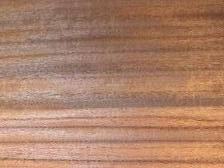
The true wood of this species is grey-brown in colour, with an orange cast and bands of darker brown and black. The clearly demarcated sapwood is cream-coloured. The texture of New Guinea walnut is moderately coarse and even; grain is moderately interlocked. Waviness of the grain often produces an attractive, broken striped figure on quarter-sawn surfaces.
As small quantities of New Guinea walnut are only sporadically exported from growing regions, commercial availability of this timber is limited.
Common Names
New Guinea walnut, Bau, Laup, Loup, Pacific Walnut, Paldao, Dao, Sengkuang, Dracontomelum spp., Dracontomelum dao
Origin
Papua New Guinea. It is also found in Indonesia, Malaysia and the Philippines.

Dark brown to black with fine black veining. A heavy, coarse-textured wood with bending and shock-resistant properties similar to ash and hickory. Hard and heavy.
Common Names
Wenge, Pallissandre
Origin
Central and Eastern Africa

Though many other species of wood can be yellow colored, perhaps few are so consistent and vibrant as Yellowheart. Some boards are a very uniform, bright yellow. Heartwood color ranges from pale to golden yellow, darkening slightly with age. Sapwood is a pale yellow/white. Yellowheart has a fine texture and a naturally high luster. Its pores are very small yielding a smooth and flat finish. The grain is usually straight, though some figured pieces may have wavy or interlocked grain.
Common Names
Yellowheart, Pau Amarello
Origin
Brazil

Highly decorative, light gold color, with narrow streaks of dark brown to black, visible by quartering. Heavy and hard, it can be polished to a high luster, but it is rather coarse in texture.
Common Names
Zebrawood, zebrano
Origin
British West Africa, Gaboon and the Cameroons

Ziricote is the most dramatic member of the Cordia genus, which grows throughout Central and tropical South America. The heartwood is dull brown with irregular dark brown and black streaking, and the sapwood is creamy white to light golden tan. A pleasing ray or fleck figure is visible in quartersawn stock. Ziricote's grain is generally straight, and its texture is medium to coarse. It takes a smooth finish and polishes well.
Common Names
Ziricote
Origin
Guatamala to southern Mexico, primarily Belize